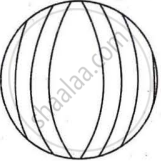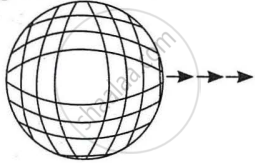Advertisements
Advertisements
Questions
With the help of suitable examples, discuss the application of Newton’s Laws of Motion in sports.
With the help of suitable sports example, explain the application of Newton's third law in sports.
Solution 1
- Newton's First Law of Motion (Law of Inertia) - According to the first law, a body will remain at rest or move at a constant velocity unless acted upon by an external (resultant) force. Inertia is the resistance of any object to any change in its motion, including a change in direction - objectives to keep moving in a straight line at a constant speed.
- Application in Sports -
- A skater gliding on ice will continue flying with the same speed and in the same direction unless an external force acts upon the skater.
- When a ball is thrown and is in mid-air, the only force acting upon it is the force of gravity. If the force of gravity did not exist, the ball would keep traveling at a constant speed until it was affected by an object or another person touched it. If this ball were thrown upwards, it would travel into space.
- Application in Sports -
- Newton's Second Law of Motion (Law of Momentum) - As per the law, the rate of change of Momentum is proportional to the resultant force and takes place in the direction of the resultant force. When a net force acts on an object, the acceleration of the object it produces is directly proportional to the magnitude of the net force, is in the same direction as the net force and is inversely proportional to the subject's masses. The more mass the thing has, the more net force has to be used to move it.
- Application in Sports -
- As in Shot-put, a player who applies more force and tosses the shot-put at the correct angle has a greater displacement of shot-put, whereas a player who exerts less force has a lesser removal of shot put.
- In soccer, a team will require more force to kick the ball high and faster. This law of motion is fundamental in soccer, so you can calculate the force needed to pass or kick the ball to the net without missing.
- Application in Sports -
- Newton's Third Law of Motion (Law of Reaction) - According to this law, there is an equal and opposite reaction for every action, and this reaction acts with the same Momentum and the opposite velocity for every action. It states that whenever one object exerts a force on a second object, the second object exerts an equal and opposite force on the first object.
- Application in Sports -
- In swimming, a diver must push down on the springboard when diving off a diving board. The springboard pushes back the force on you for proper projecting into the air during the performance.
- Application in Sports -
Solution 2
Newton's third law states that for every action, there is an equal and opposite reaction.
In swimming, Newton's third law is evident in the propulsion generated by a swimmer's arm strokes against the water. When a swimmer pulls their arm through the water with force (action), the water exerts an equal and opposite force backward on the swimmer's hand (reaction). This reaction force propels the swimmer forward through the water.
RELATED QUESTIONS
Study the pictures given below:
 |
 |
| (A) | (B) |
| Stationary Ball | Moving Ball |
Based on your above study and your knowledge, answer the following questions:
- Which law of motion will be applied to initiate motion of the ball as depicted in illustration (A)?
- In illustration (B) which force is acting upon the ball to slow it down?
- Which law of motion will determine the quality of bounce?
- ____ of an object directly depends upon the mass of the object and net force applied on it.
OR
"When a cricket ball is moving with a certain velocity, the player has to apply retarding force to bring the ball at rest in his hands." Which Newton's Law is applied in this illustration?
Identify the given below

